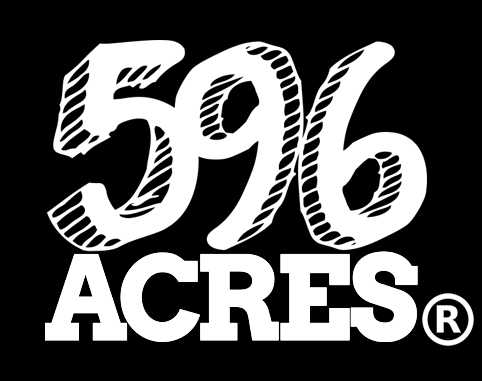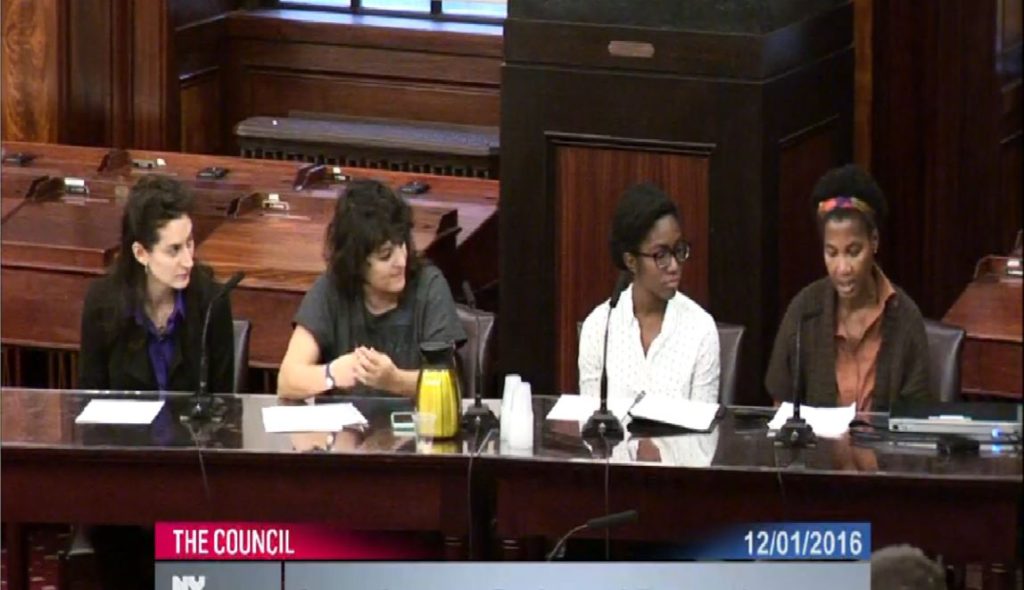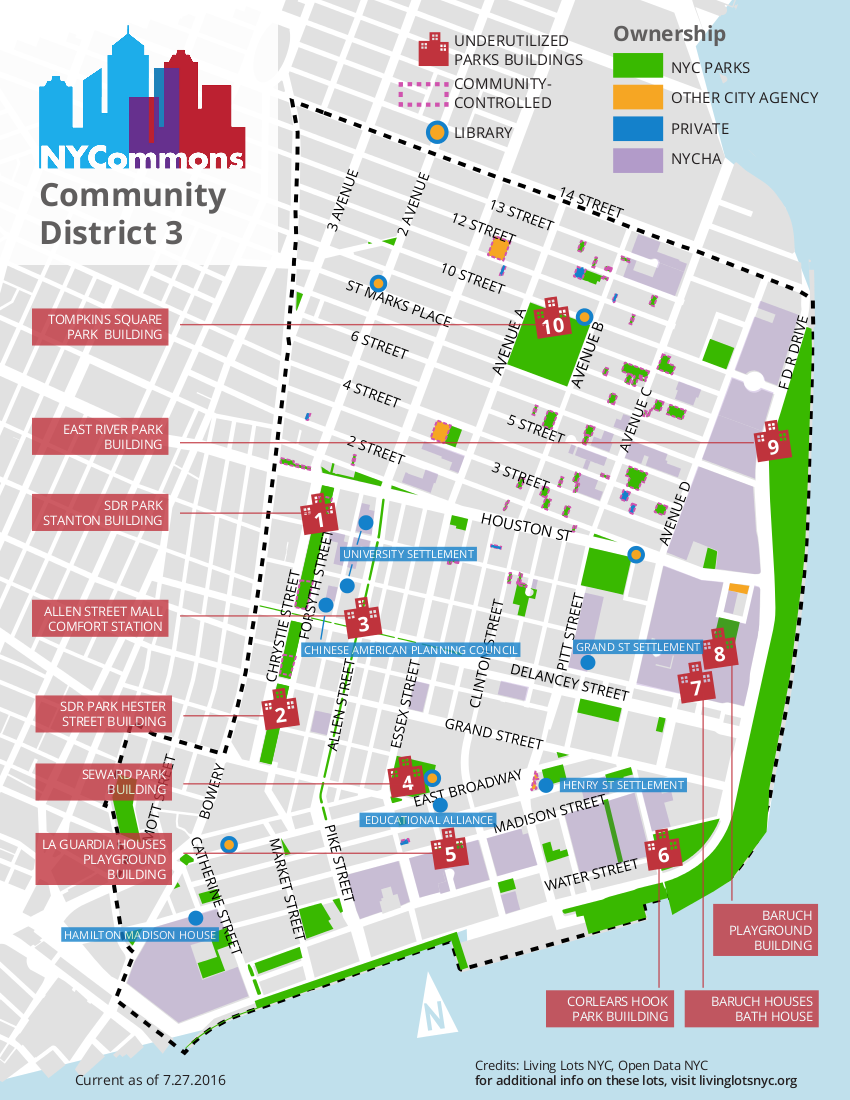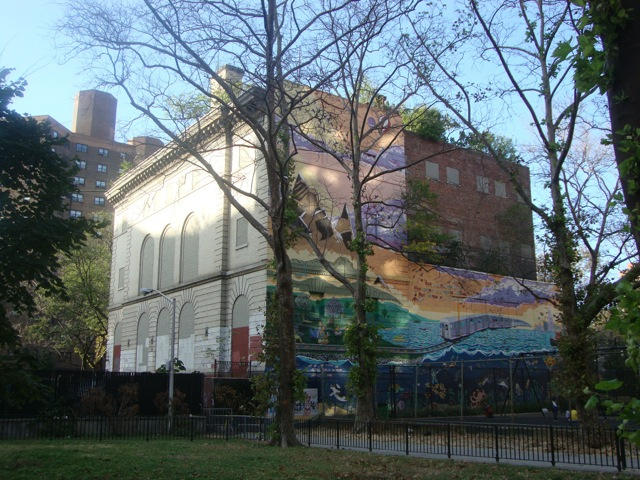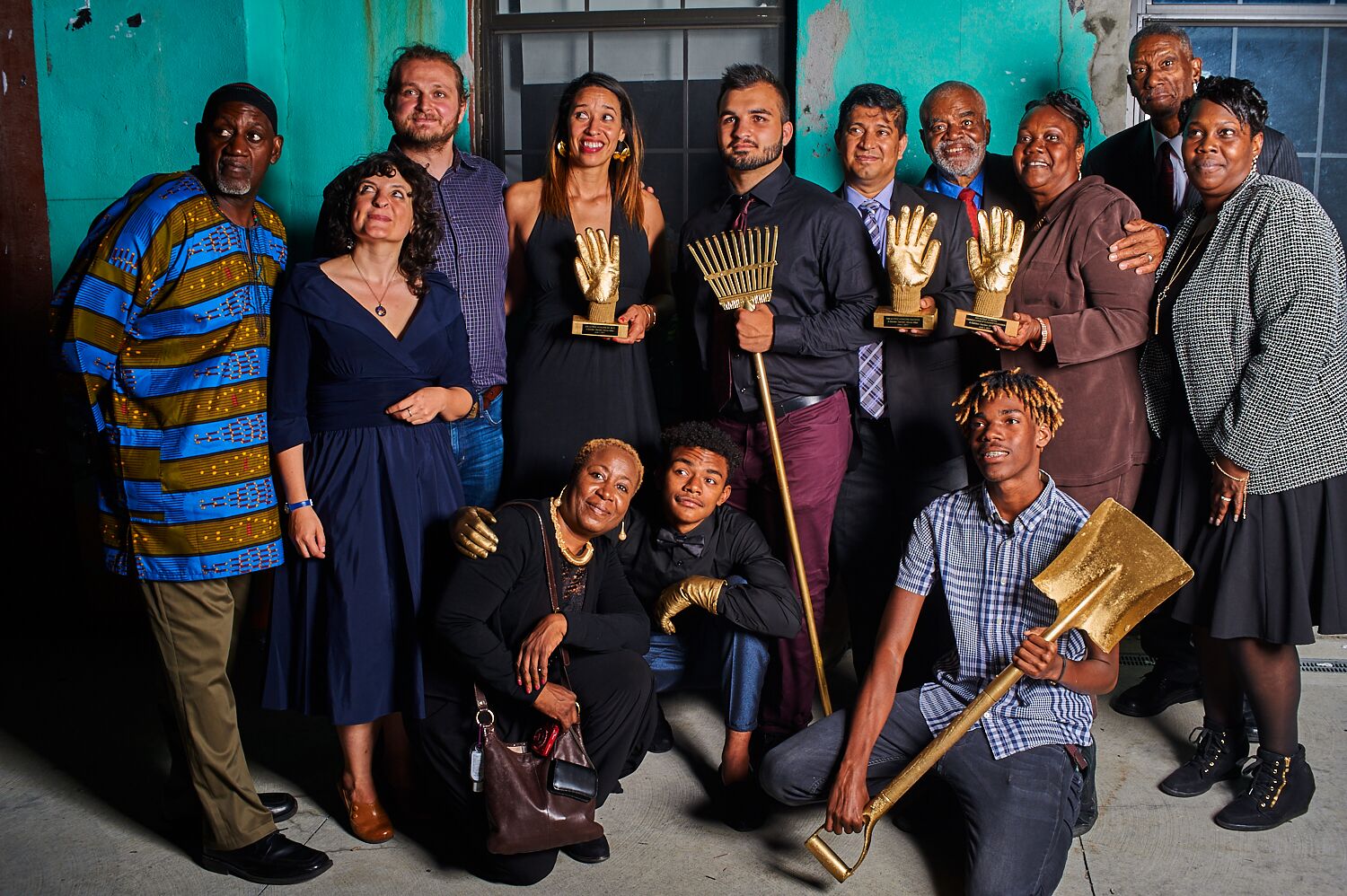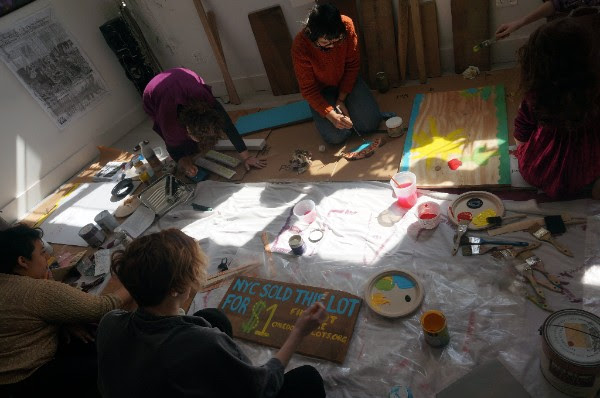Across NYC, acres of Parks Department land sit behind fences. Dozens of Parks Department buildings are boarded up. Last Thursday, December 1, City Council’s Committee on Parks and Recreation hosted a public hearing: “An Examination of Parks Department Properties Currently Inaccessible to the Public.”
With organizers in our network and fellow advocates, 596 Acres testified about the impacts of these properties in our neighborhoods and city. We presented first-hand information about these places along with powerful ideas for reactivating abandoned public land and buildings through Parks Department surveys of its assets paired with nonprofit and resident stewardship.
Use these links to navigate our testimonies below. City Council’s video of the hearing is posted here; we go on at the times noted:
- All NYC Parks Assets – testimony from Paula Segal and Mara Kravitz of 596 Acres (02:02:15)
- Baruch Houses Bath House on the Lower East Side, Manhattan – testimony from Jamie Jensen of NYC H2O (02:32:12)
- Ridgewood Reservoir and High Bridge Tower and Gatehouse in Highland Park, East New York straddling Brooklyn and Queens, and Central Park Gatehouse in Manhattan – Matt Malina of NYC H2O (02:23:20)
- Stanton Building in the Lower East Side, Manhattan – Wendy Brawer (02:58:40) and K Webster (03:02:50) of the Sara Roosevelt Park Coalition and Stanton Building Task Force
- Corporal Fischer Park and surrounding Parks properties in Highbridge, Bronx – Dian Hawkins (02:07:23), Sabeena Prescod (02:11:40), Sharon Griffin (written only), Steven Jackson (written only), and Alix Fellman of the Women’s Housing and Economic Development Corporation (03:15:56)
- Hilton Holiday Gardens in South Jamaica, Queens – Trish Van Buren of HipHoticHelps (02:54:40)

Thank you for accepting our testimony and holding this crucial hearing today. My name is Mara Kravitz and here with Paula Segal on behalf of 596 Acres, New York City’s Community Land Access Advocacy organization. We help regular New Yorkers organize around and gain access to the city’s vacant properties to transform them into community spaces that provide vital public services. We have enriched 38 neighborhoods by facilitating the transformation of inaccessible and dormant spaces into community resources in the form of pocket parks, gardens and farms since 2011 and contributed to the preservation of dozens of existing spaces. We are working with advocates from dozens of other neighborhoods who are targeting their local fenced off lots and abandoned public buildings for revitalization.
You will hear from some of them today about these specific spaces. Just as an example, we are currently supporting organizers in Highbridge, South Bronx, in planning for the future of Corporal Fischer Park, which has been inaccessible to the public for over 20 years – despite the Parks Department sign on the fence. This public Parks property used to be so strewn with trash that neighbors couldn’t walk the sidewalk in front of it.
Part of our work is turning municipal data into information useful to the public. To this end, we keep an online map of vacant public land in New York City, developed using a combination of the best available data from City Planning and the Department of Citywide Administrative services, ground truthing by our staff and organizers, and property-specific research. That map is a good starting point for identifying vacant and inaccessible NYC Parks properties: according to our research, there are at least 27 places in New York City where land in the inventory of the NYC Parks Department sits idle and inaccessible, and that’s just what we know right now. Our research is based on data that is gathered by agencies with agendas other than the creation of vibrant and open community spaces. We hope that one outcome of this oversight hearing today will be an imperative to the NYC Parks Department to survey its own land holdings and make that data available to residents and their advocates, including the Council itself.
In addition to vacant Parks Department land, we have begun to survey of vacant Parks Department buildings. We started with the list of New York City properties published on the Open Data portal by the Department of Citywide Administrative Services and narrowed it down to only Parks properties with structures on them. We have been using online tools and our feet and eyes to actually explore the status of these structures. With volunteer labor, we have already uncovered 35 vacant public NYC Parks buildings, including 10 buildings in Manhattan Community District 3 on the Lower East Side alone (where our investigation began). Today, we are providing you a map of that District. But these properties are strewn across the City: There is an unused stable, used as a Fire Communications building in the middle of Central Park and the closed Queensbridge Park Fieldhouse, a Works Progress Administration building built as a community center.
NYC Parks does not have accessible comprehensive data about its buildings. Our hope is that another outcome of today’s hearing will be an imperative to the NYC Parks Department to survey its own building holdings and make that data available to residents and their advocates, including the Council itself.
These buildings were all built for public use with public funds. Most were closed during the fiscal crises of the 1970s and never re-opened. These are opportunities for community centers, public restrooms, cooperative food businesses and more. Without knowing where they are, we cannot start the process of planning.
Inaccessible NYC Parks Department properties are scattered throughout the City but located primarily in low-income neighborhoods where communities of color live. Dozens of fenced-off lots and boarded-up buildings in the inventory of NYC Parks sit vacant, locked and forgotten, abscesses in the very neighborhoods that most need more healthy resources. The effects of the Parks Department’s abandonment of these properties only compounds a history of redlining, block busting, urban renewal clearance and municipal neglect. We are really pleased to see this Council initiating a process through which together we can change course.
Baruch Houses Bath House on the Lower East Side, Manhattan – http://livinglotsnyc.org/lot/1003230002/
<
My name is Jamie Jensen. I live in Lower Manhattan and work for NYCH2O.org, an environmental education non-profit, and I am here to testify about the hugely positive potential impacts of restoring and re-opening a currently inaccessible NYC Parks Department property located at Manhattan Borough Block 323 Lot Number 002. Street address is 326 Delancey NY NY 10002.
This large, neoclassical building, a 115-year-old landmark located along the easternmost section of Rivington Street on the Lower East Side, pays tribute to two generations of New Yorkers whose work, directly and indirectly, helped bring health and recreation amenities to the masses. More than a century ago, new immigrants arriving on the Lower East Side were forced into congested tenement districts where overcrowding threatened their health and welfare, and epidemics of cholera and typhoid raged because of a lack of clean water and basic sanitation facilities.
Dr. Simon Baruch (1840-1921), who served as a surgeon during the Civil War, witnessed firsthand the debilitating effects of unhealthy water and lack of sanitation. In 1889 Dr Baruch voiced the first plea for public bathhouses, and in 1901 New York City completed and opened this building. Then known as Rivington Street Public Baths, the building featured indoor and outdoor bathing pools, as well as showers, tubs and changing rooms. In 1939, Bernard Baruch (1870-1965), son of Dr. Simon Baruch and noted financier, donated the surrounding land to the city, and the NYC Parks Dept assumed jurisdiction, renovating the bathhouse with better recreational facilities and constructing Baruch Playground on an adjacent site. Since the 1950s urban renewal era, when the New York City Housing Authority (NYCHA) preserved Baruch Baths while building Manhattan’s largest public housing complex, NYC Parks Dept has administered this property for NYCHA, but in 1975, when a long fiscal crisis made the facility too expensive for the cash-strapped city to operate, the recreation center at Baruch Baths was closed.
As you can see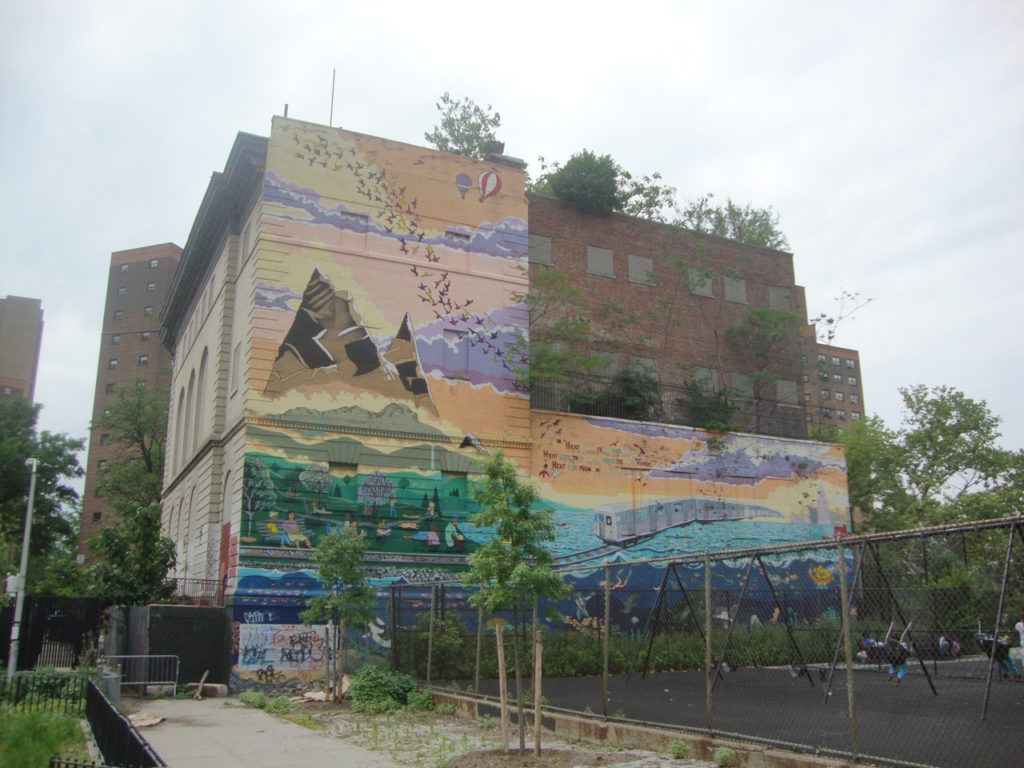 from the photos I’ve pasted, at present this once-proud public amenity stands as an all-too-vivid reminder of under-investment in New York City’s most marginalized communities. With support from the City Council and other agencies, the bathhouse could be brought back to productive life, perhaps being incorporated into the more than $1.5 billion of capital projects that’s being invested in post-Sandy resiliency efforts in the immediate vicinity of this long-neglected landmark. Particularly in light of the fact that NYC Parks Dept is giving up significant portions of its existing recreation sites in adjacent East River Park to construct these resilience projects, I ask the Parks Committee to do whatever it can to encourage the revival of this potentially valuable but currently inaccessible city-owned property.
from the photos I’ve pasted, at present this once-proud public amenity stands as an all-too-vivid reminder of under-investment in New York City’s most marginalized communities. With support from the City Council and other agencies, the bathhouse could be brought back to productive life, perhaps being incorporated into the more than $1.5 billion of capital projects that’s being invested in post-Sandy resiliency efforts in the immediate vicinity of this long-neglected landmark. Particularly in light of the fact that NYC Parks Dept is giving up significant portions of its existing recreation sites in adjacent East River Park to construct these resilience projects, I ask the Parks Committee to do whatever it can to encourage the revival of this potentially valuable but currently inaccessible city-owned property.
Thank you for holding this Oversight Hearing to examine Parks Department properties currently inaccessible to the public. Reviving and reopening this historic property in collaboration with local residents will ensure its enduring benefit to the neighborhood and the City.
Jamie Jensen
Jamie@NYCH2O.org
Ridgewood Reservoir and High Bridge Tower and Gatehouse in Highland Park, East New York, Brooklyn & Queens – http://livinglotsnyc.org/lot/59256/; Central Park Gatehouse in Manhattan
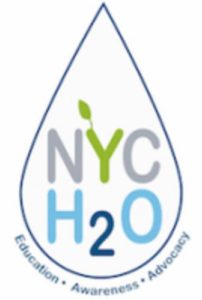
I am Matt Malina, the founder and director of NYC H2O, a non-profit organization that provides education programs about New York City’s water system and ecology. Our biggest organizational growth comes from the increasing participation of underserved Title I and Title III New York City schools. Since 2014, we have provided 283 free Water Engineering and Ecology Field Trips reaching over 7,300 students. We engage students and the public with outdoor experiences at eight inspiring water ecology and infrastructure sites located in city parks in all five boroughs. We offer similar programs to family and adult audiences as well as provide volunteer beach-cleanups that engage New York City youth.
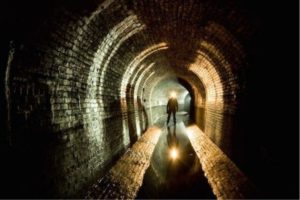
Inside the Croton Aqueduct, photo by Steve Duncan
Three of our park sites have areas that are not currently accessible to the public. Opening these locations would add to the experience of these parks in meaningful and memorable ways. They are the Ridgewood Reservoir, High Bridge Tower and Gatehouse, and Central Park Gatehouse (DEP).
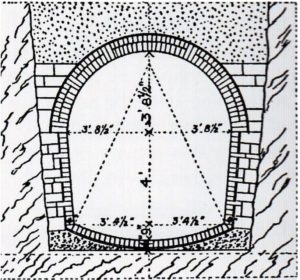
Engineering drawing of the Croton Aqueduct 1842, Fayette B. Tower
Ridgewood Reservoir – The Ridgewood Reservoir in Highland Park is a 50+ acre natural oasis that straddles the East New York neighborhood’s border of Brooklyn and Queens. Built in 1859 to supply the once independent City of Brooklyn with high quality water, it became obsolete with the addition of new reservoirs in the Catskills and was decommissioned in the 1980’s. Since then, nature has taken its course in a perfect case study of ecological succession. A forest has grown in the two outside basins while the middle basin’s freshwater pond is an avian stopover on the Atlantic Flyway.
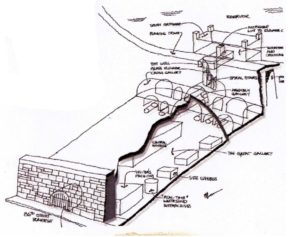
Source: DEP engineering study to reduce dry weather flow to Wards Island sewage plant conducted by Malcom-Pirnie in 1997
We conducted a community survey of the Ridgewood Reservoir. 62% of respondents want an accessible boardwalk that descends into the basins to allow closer observation of this unique, magical landscape. The nearby residents want to have access to what is now a locked away ecological asset. This should be a priority for any Equity in the Parks initiatives.
High Bridge – The High Bridge is NYC’s oldest bridge and was built in 1848 to carry the Croton Aqueduct across the Harlem River. It was renovated skillfully and reopened to the public in June 2015. The gatehouses are safe and being able to go inside them with students and the public to see the Croton Aqueduct would be incredibly instructive to explain the function of the bridge. Students always ask if they can go inside the gatehouses of the High Bridge.
Central Park Gatehouse (DEP) – In 1997, there were plans drawn up to turn it into a museum about water and I have attached a schematic here. It would be an ideal location and setting for such a museum.
Matt Malina
matt@nych2o.org
Stanton Building of Sara D. Roosevelt Park, Lower East Side, Manhattan – http://livinglotsnyc.org/lot/6000010013/
Jump to:
Wendy Brawer
K Webster

My name is Wendy Brawer. I’ve lived and worked on the Lower East Side since 1987.
I am here to testify about the impacts of the inaccessible parks department building in Sara D Roosevelt Park, specifically the Stanton Building (on Stanton Street between Chrystie and Forsyth). I live and work near this building. It used to be a community center, but Parks stores materials for the entire Borough in it.
Given its prime location outside lower Manhattan’s extensive Flood Zones, I believe the Stanton Building would be an excellent Resiliency Center, where community members can learn impact-reducing skills (such as bike repair, energy efficiency, waste reduction, and other sustainable living habits) and preparedness skills. The building can double as an emergency center, and provide communications, power and other services when needed during a disruption.
Like many Park Houses, the Stanton Building was closed as a community center in the 1970’s or 80’s. As far back as 1998, Parks indicated the building would be returned to the community. We were permitted to see the inside in September 2015, with City Councilmember Chin, Parks staff and members of SDR Park’s Community Coalition. The exterior looks good, but inside, it needs extensive repairs. The first funding ($1million) for new bathrooms has been allocated by MBP Gale Brewer and Councilmember Chin. A design for the bathrooms will be presented by Parks at the January 2017 CB3 Parks committee meeting. No community input has been requested, although Parks was invited to three visioning sessions held in July 2016 (see attached).
The community surrounding SDR Park includes many deaf residents, low income immigrants and their families, as well as other new arrivals to NYC. Approximately 150 diverse community members took part in the three events (see attached). Held in conjunction with NYC Commons, one disproportionate fact stood out – the Lower East Side has more underutilized Park Houses than any other Manhattan district. We also have less parkland per capita than other districts.
With trucks coming and going all day long in this narrow park, using this building as a storage facility creates a safety hazard. Moreover, pollution that impacts all New Yorkers is generated by trucks coming all the way downtown to collect supplies each day. This expensive and time consuming, and at minimum, storage should be more central. Parks uses two other buildings in SDR Park, and perhaps the storage can be relocated further south (we have also suggested other locations and tactics such as procurement subscriptions so less space is needed to store products).
The Stanton building could serve the community as an innovative Resiliency Center. Community members want to learn repair skills, how solar energy can be installed where they live and work, how to co-develop innovative waste reduction and rainwater catchment, and do more to support everyday sustainability. We could have a community meeting space, tool library and even a kitchen. People also like the idea of including cultural exchange and recreation, and providing services for homeless community members.
As a member of LES Ready (post-Sandy long term recovery group), I am well aware of the need for emergency space, and this place is ideally located for that purpose. Moreover, there is no other location for the kinds of capacity building described here; indeed, we are losing community spaces all the time. In an era when the effects of climate change are just starting to impact our city, many of us, including Rob Watson, the ‘father of LEED’ agree that resiliency is dependent on community engagement of this kind, and that the Stanton Building is very well suited for it.
I am eager for the Parks Department Building “Stanton Storehouse” in Sara D Roosevelt Park to be returned to public use. It is just one of dozens across NYC that the public cannot access. These are opportunities for community centers, public restrooms, cooperative food businesses and more. Reopening these buildings to serve the public, and planning for their future use in collaboration with local residents, will ensure their lasting benefit to our neighborhoods and City.
Wendy Brawer
Director, Green Map System
Member of the Stanton Building Task Force and SDR Park Community Coalition
* * *
My name is K Webster I am the President of the Sara Roosevelt Park Community Coalition. I lived on Forsyth Street on this Park from 1978 to 1990 when I moved to the nearby Bowery.
Our narrow Park has four park buildings in it. Three are used by Parks Department to serve the needs of the five boroughs and all of Manhattan. The forth building houses the BRC Senior Center. That building bristles with joy and purpose and is an oasis of caring for our local community.
SDR Park spans over half a mile from East Houston Street to Canal Street and is 8 acres in size. It currently has one available public restroom on Hester Street.
I am here to testify about the impacts of just two of the inaccessible Park’s buildings here. One is at Hester Street and the other is at Stanton Street. Our focus is on Stanton Street as the area most urgently in need of a neighborhood anchor.
Robert Moses built this park in 1934 after a failed Tammany Hall scheme left it a barren wasteland. In 1959 gang wars left two teenagers dead. From 1970 – 1985 the area was an open-air drug market. In 1982 the Coalition founded a Garden along with a Senior Center at Rivington and Delancey Streets (Gail Collins called the Garden the Normandy Beach of the fight to reclaim SDR Park). The neighborhood rose up to remove violent drug dealers and pimps. But in 1994 the steps of the Stanton building were still a shooting gallery.
For a while this building held “a safe haven program for neighborhood kids”. It was a rec center until Parks closed it and it never reopened – rumor has it people weren’t using it because the park still seemed too dangerous.
The building at Stanton Street currently serves the purpose of a depot for all Manhattan Parks. It cannot hold all the storage – the overflow has been installed in a large cargo container that sits to the side of the building. This takes up yet more park space and provides a hideout for drug use and homeless storage. Its bathrooms have been inaccessible to the public since about 1994 when the neighborhood was promised its return as a recreation center. The Department’s cars, trucks and private vehicles engulf the pathway in front of it. A tree recently planted by young people from LES Prep was run over by one of the vehicles. We think that points up the dangerous condition of using the pathway as an active driveway. The building sits across from a stand of Citibikes, four high schools, a basketball court, a children’s playground and a shower spray.
What We’ve Done:
We have asked for and received Community Board 3 resolutions since 2010 requesting the Stanton building be return to public use. It has been a high priority on our District Needs statement for many years.
Hester Street Collaborative did a study of the building in 2012. I wrote an op-ed in February 2013. Articles have been written, and more studies have been made before and since on returning the building to public use.
In April 2013 Commissioner Castro announced that Parks had officially submitted the Stanton Street Building into their capital project planning process.
In 2013 we were told an alternate site had been found for the storage but it fell through. We’ve offered other possible options.
In 2014, at our request, we were given an estimate from the Parks Department for the renovation of the entire building (assuming the storage could be moved) of under $5 Million (including lead and asbestos abatement). We offered to fundraise with nearby, new luxury projects.
We have met with Manhattan Parks Commissioner often on this subject.
In 2013 and 2014 Parks received a combined million dollars in grants from Manhattan Borough President Gale Brewer and Councilwoman Margaret Chin requested by Coalition members for the building.
In 2015 we did a walk-through of the building with the Commissioner and Council Member. It was our second walk-through.
We’ve organized numerous It’s My Park Days to advocate for renovations and done clean ups and plantings. We’ve organized visionings for the neighborhood and the park-going public to weigh in on their wishes for the site.
In July of last year in partnership and with a grant from NYCommons we held three visionings for the community on the Stanton Street building. Neighborhood’s parents who used to play there expressed a strong desire to see it available for their children. No one requested it remain a storage facility.
This Parks Department building could serve the community as an anchor for the northern end of the park. It could serve as a crime deterrent. We could have a resiliency center, neighborhood hub, CSA, bottle redemption center, homeless information center, bike repair, solar hub powering station, community center, teen center for young people learning resiliency skills, …the possibilities are many. We’d like to see Parks turn the building over to one of our strong community partners to program, to share space, to monitor and build a core of stewards for this section of the park. As the Coalition we’d want to hear from the community and Parks Department about these possibilities.
The continuing collapse of structural supports for low-income people is just one of the many reasons we think that all publicly owned buildings must be enlisted to serve the public. It’s past time to activate the creativity and intelligence of neighborhoods, electeds and City agencies to good and collaborative use in solving what looks like will be a very difficult next few years.
Articles on Stanton Building:
- http://thevillager.com/2016/11/23/33225/
- https://www.dnainfo.com/new-york/20160525/lower-east-side/sara-d-roosevelt-park-still-need-of-public-restrooms-locals-say
- www.thelodownny.com/leslog/2013/02/oped-its-time-to-reactivate-stanton-street-park-building.html
- http://www.thelodownny.com/leslog/2015/02/some-lower-east-side-parks-projects-receive-funding-while-others-languish.html
- http://thevillager.com/2012/10/18/study-seeks-new-uses-for-forgotten-park-buildings/
- http://thevillager.com/2016/08/04/building-power-in-local-parks/
- http://bedfordandbowery.com/2016/07/lower-east-side-community-imagines-a-future-for-sara-d-roosevelt-parks-stanton-building/#
- http://www.boweryboogie.com/2016/07/store-no-time-reactivate-stanton-building-sara-d-roosevelt-park-locals-say/
- https://www.dnainfo.com/new-york/20160706/lower-east-side/task-force-launches-workshops-turn-parks-building-into-youth-center
- http://www.thelodownny.com/leslog/2016/07/campaign-to-reactivate-stanton-street-park-building-resumes-today.html
- http://thevillager.com/2016/07/21/push-to-restore-stanton-storehouse-to-community/
K Webster
President
Sara Roosevelt Park Coalition
http://sdrpc.mkgarden.org/
Corporal Fischer Park and surrounding Parks properties in Highbridge, Bronx – http://livinglotsnyc.org/lot/58248/ & http://livinglotsnyc.org/lot/59053/
Jump to:
Dian Hawkins
Sabeena Prescod
Sharon Griffin
Steven Jackson
Alix Fellman (WHEDCo)
My name is Dian Hawkins. I am here today from the Bronx. I have lived in the Highbridge neighborhood for over 30 years.
I am here to testify about the impact of the inaccessible Parks Department properties in my neighborhood, Council District Bronx 16 and Bronx Community District 4. Particularly I am going to tell you about a fenced off area located between West 169th and 170th Street between Nelson and Shakespeare Avenues – Bronx block 2519 lot 32 and Bronx Block 2520 lot 19, which is adjacent to a vacant public DOT lot. The sign on the fence, which has been closed for the decades I have lived here, says it is called Corporal Fischer Park.
I lived near this property and often walk by just to see what’s new. In the summer days, it brings much sadness to the neighborhood. Sometimes it’s an eyesore. When I stand by it and observe, children playing on the sidewalk ask me, Why is this park always closed? Is there something wrong with it? Why can’t we use it?
Over the past years, it has been very much neglected. You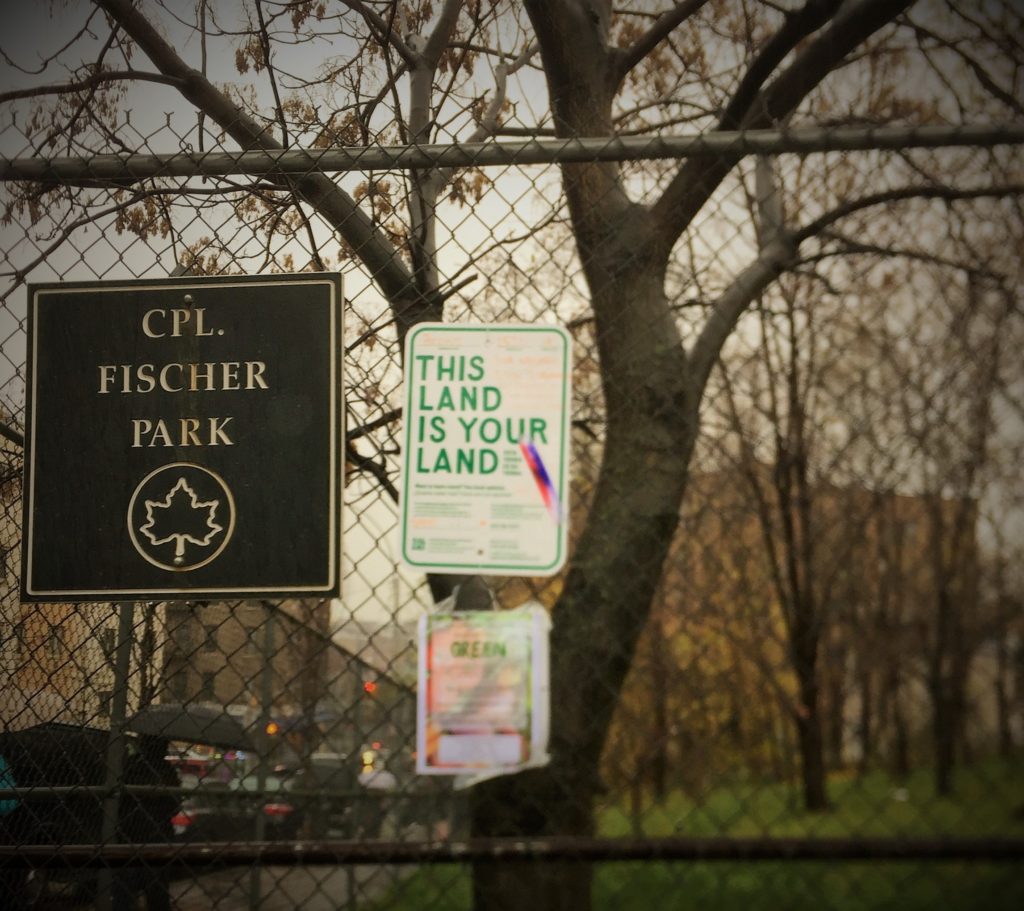 used to not even be able to walk on the sidewalk outside the fence of this public lot. In 2016, the Parks Department finally started cutting the grass and cleaning it up. The lots remain enclosed by fence and padlock, but now are sometimes cleaned.
used to not even be able to walk on the sidewalk outside the fence of this public lot. In 2016, the Parks Department finally started cutting the grass and cleaning it up. The lots remain enclosed by fence and padlock, but now are sometimes cleaned.
The City has owned the land for 20 years. Parks Department took jurisdiction over it about 7 years ago to create a park meant to honor Corporal Irwin A Fischer, a New Yorker who served in the Army Air Corps during World War II and flew in locations including Iwo Jima, the Philippines and Saipan. It is kept locked up because it’s undeveloped. I was also told by Elizabeth Gonzalez from the CD4 District Manager’s office in April that the Parks Department does not have the funding to develop it, and it’s a major capital improvement to make a park.
I’ve been an active member of my community, engaged in communal activities from helping the homeless to cleaning up litter to maintaining our parks and community gardens. Through this, I worked with New York Restoration Project, Bronx Botanic Garden and GreenThumb, and realized the potential of this space. Over the past couple of years, I started feeling connected to it. I see so much potential each time I stop by. I develop more ideas and fondness for it as a respite for a hot summer heatwaves, especially for seniors who live in the senior housing across the street.
Now we are organizing to make Corporal Fischer Park real and planning for what kind of park we want it to be.
We see the potential for it to become a flourishing and rewarding community green space for the growing community’s residents in a neighborhood where open space and growing space is limited. It will expose students to environmental and sustainable urban environment in their communities, providing teaching and learning opportunities for all residents willing to learn about the environment and how plants grow. It will be the location of community activities that will enrich and have lasting benefits to our residents and neighborhood. It will help to promote health and wellbeing in today’s stressful environment – and organic oasis to meditate, relax, rejuvenate.
Thank you for holding this Oversight Hearing to examine Parks Department properties currently inaccessible to the public. Though there is inaccessible and underutilized NYC Parks property in my neighborhood, I wouldn’t have known about this hearing without an invitation from 596 Acres. Turning these properties into real parks in collaboration with local residents will ensure their lasting benefit to our neighborhoods.
(929) 575-3438
dian_mhawkn715@yahoo.com
* * *
My name is Sabeena Prescod. I live in West Concourse. I am here to testify about the impacts of inaccessible parks department properties located at Block 2519, Lot 32 and Block 2520, Lot 19 located at W 169 th and W 170 th Streets between Shakespeare and Nelson Avenues. I live near and bike past these properties, and they are sadly abandoned, fenced off, and full of potential — especially in an area that already has many new multifamily buildings and will continue to see an influx of new residents in the coming years but lacks adequate greenspace for everyone to comfortably enjoy.
The properties are and have been Parks Department properties for at least 6 years. Previously, city records show that any buildings that were on these lots were demolished by 1981, and they have been empty ever since.
I am eager for the land at Block 2519, Lot 32 and Block 2520, Lot 19 to become open parks with resident participation in planning. Locals are already organizing to create a vision for this park. We would like green space for communal vegetable and flower gardening, picnic space, and a space for children to play. We are also set on having space accessible and safe for the many seniors in who live within a block of either lot. A space with a combination of active and passive uses would be ideal. We also have connections to community members and organizations vested in establishing long term community projects that will create employment and educational opportunities for residents of all ages.
Thank you for holding this Oversight Hearing to examine Parks Department properties currently inaccessible to the public. Even though I live near two of these properties, I would not have known about today’s hearing if not for the assistance of 596 Acres. More needs to be done in the future to advertise these hearings to the public which offer valuable insight into the process and limitations of making iconic and important public spaces accessible. Turning the properties in my area into real parks in collaboration with local residents will ensure their lasting benefit to our neighborhoods and City.
(914) 263-2454
sabeena.prescod@gmail.com
* * *
th Street (Bronx block 2520, lot 19) and at W 169th Street (Bronx block 2519, lot 32), both between Shakespeare and Nelson Avenue.
Since 1978, I have lived in the neighborhood, right near these properties. They have been abandoned the whole time.
The one on W 169th street has a sign that says Corporal Fischer Park. There used to be a building on this site. Once it was demolished, the site was abandoned. It has been vacant for over 20 years. There has never been a park here, but there has been the Parks Department sign. It is has never been accessible.
My neighbor Dian has been inquiring about how to transform the vacant lots in the neighborhood into green community space for years, attending Community Board 4’s Parks Committee meetings. She found out this lot is already in the Parks Department, and began organizing for community access to an open green space here starting last spring. Now we are coming together to plan what kind of park we want it to be.
I am eager for these abandoned NYC Parks properties in my neighborhood to become real parks. I definitely want community green space – a tranquil environment for seniors to gather and children to play. I want a picnic area with nighttime lighting, flower beds, and space to grow food.
Thank you for holding this Oversight Hearing to examine Parks Department properties currently inaccessible to the public. Though there is inaccessible and underutilized NYC Parks property in my neighborhood, I wouldn’t have known about this hearing without an invitation from 596 Acres. Turning these properties into real parks in collaboration with local residents will ensure their lasting benefit to our neighborhoods.
OrganizeCFLot@gmail.com
* * *
My name is Steven Jackson. I live in Highbridge in the Bronx.
I am testifying about the impacts of inaccessible Parks Department properties located at West 170th Street (Bronx block 2520, lot 19) and at W 169th Street (Bronx block 2519, lot 32), both between Shakespeare and Nelson Avenue.
This property is behind a seven foot fence. It’s been vacant for the last 13 years that I have lived in the neighborhood. The Parks Department has keys to it and recently started to clean it up. The building that was there before was demolished, but nothing else was ever done. I’m working with a group now to try to gain access to this property.
I am eager for our neighborhood to have a real park – we really need it! I envision a playground, a sprinkler system, an area for seniors, a picnic area with barbeque grills, and night lights.
Thank you for holding this Oversight Hearing to examine Parks Department properties currently inaccessible to the public. Though there is inaccessible and underutilized NYC Parks property in my neighborhood, I wouldn’t have known about this hearing without an invitation from 596 Acres. Turning these properties into real parks in collaboration with local residents will ensure their lasting benefit to our neighborhoods.
OrganizeCFLot@gmail.com
* * *
Good afternoo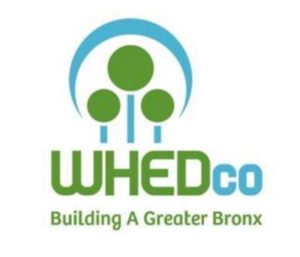 n, my name is Alix Fellman and I am a Senior Program Manager at the Women’s Housing and Economic Development Corporation (WHEDco). Our community development work focuses on improving quality of life for families and individuals in the South Bronx; parks and open space are essential components of healthy, vibrant communities.
n, my name is Alix Fellman and I am a Senior Program Manager at the Women’s Housing and Economic Development Corporation (WHEDco). Our community development work focuses on improving quality of life for families and individuals in the South Bronx; parks and open space are essential components of healthy, vibrant communities.
NYC Parks has been a partner on several of our past projects to revitalize and activate underutilized parks and open space. We have hosted clean-up days and painted murals, and we’ve installed Boogie Down Booths – colorful temporary installations that provide seating, solar-powered lighting, and music – in two Parks properties, including Seabury Park, a Community Parks Initiative site. However, we regularly hear from residents in all our neighborhoods that they need greater access to parks and open space.
Today I’d like to focus on City Council District 16, which overlaps the southern portion of the Jerome Avenue Study Area currently being considered for rezoning. Although the area has some large Parks properties, such as Mullaly Park and Macombs Dam Park, the quantity, quality, and accessibility of parks severely declines north of 167th Street and west of the Grand Concourse, all the way north to the Cross Bronx Expressway. Of the few Parks properties in this area, two are closed to the public, behind fences and locked gates: Corporal Fischer Park, which consists of two unconnected, undeveloped, and overgrown parcels, one on West 170th Street and one on West 169th Street and Nelson Avenue; and Jerome Playground, on a former handball court on Jerome Avenue overlooking the Cross Bronx Expressway. Together, these properties represent almost an acre of public park land.
While we applaud DCP’s proposal through the rezoning to de-map Corporal Fischer Place and open Corporal Fischer Park, we believe that the Parks Department, which purchased the park in the 1990s and has left it closed off for years, has a responsibility to invest in this park independent of the rezoning. Additionally, DCP’s Draft Scope of the Environmental Impact Statement does not include plans for the West 169th Street lot of Corporal Fischer Park. We hope that Parks recognizes that opening and investing in only one of the park’s two lots will not be sufficient for this growing community.
The neighborhoods surrounding Corporal Fischer Park and Jerome Playground are very dense, with a high percentage of seniors and families with young children. The City considers this area adequately served by open space, but while some parks may technically fall within a half mile radius of people’s homes, this measurement does not take into account physical barriers that limit accessibility for many of our community members, such as steep hills and dangerous major roadways. This measurement also does not take into account the size or quality of nearby open space. According to New Yorkers for Parks, City Council District 16 has just 2.6 acres of parks and playgrounds per 1,000 children, compared to a citywide average of 13.3 acres. The district also has just 9.2 acres of parks and playgrounds per 1,000 seniors, compared to a citywide average of 23.3 acres. Opening Corporal Fischer Park and Jerome Playground will add nearly an acre of public space, but this community still needs more parks and playgrounds, especially since the proposed rezoning is expected to bring 12,000 additional residents to the neighborhood.
We encourage NYC Parks to work closely with community residents to redesign and open Corporal Fischer Park and Jerome Playground, and to invest in improvements to other Parks properties that are little more than concrete and benches, like Inwood Playground or Keltch Park. We also hope that future assessments of park accessibility will take into account physical barriers, size and quality of available open space. Thank you.
 Hilton Holiday Gardens in South Jamaica, Queens – http://livinglotsnyc.org/lot/59257/
Hilton Holiday Gardens in South Jamaica, Queens – http://livinglotsnyc.org/lot/59257/
My name is Trish Van Buren. I was born and raised in South Jamaica Queens. I am here to testify about the impacts of an inaccessible parks department property located at Block 12089 Lot 8 in South Jamaica, Queens. This property is located between 133rd and 135th Avenue, and 143rd and 145th Streets.
I was driving past the property on my way to work and noticed it was called the Hilton Holiday Garden. It seemed to be abandoned. With the increased investment in the South Jamaica community, this property looks out of place. We are in the holiday season and there are no signs of maintenance, nor even a hint of holiday lights ready for installation. There is a unattractive low metal border rail surrounding the perimeter of the property. There are trees and bushes are dying on the property. I was pretty shocked that a community garden operated by the Hilton would be represented in such a weathered way.
I am the founder of HipHoticHelps, a non-profit that harnesses 57 community-based programs under our mantra, “BANSAKEHM,” the acronym for the 9 sciences of survival: Body, Agricultural, Nutritional, Spiritual, Astrological, Kemetic, Economical, Historical and Military Science. BANSAKEHM has led our search and evaluations for inaccessible parks department property and abandoned lots to convert them into the colorful vision for the HipHoticHelps Essential Garden. Our plans include grassroots labor and an outreach with collective groups of community members, leaders, educators, advocates, and liaisons.
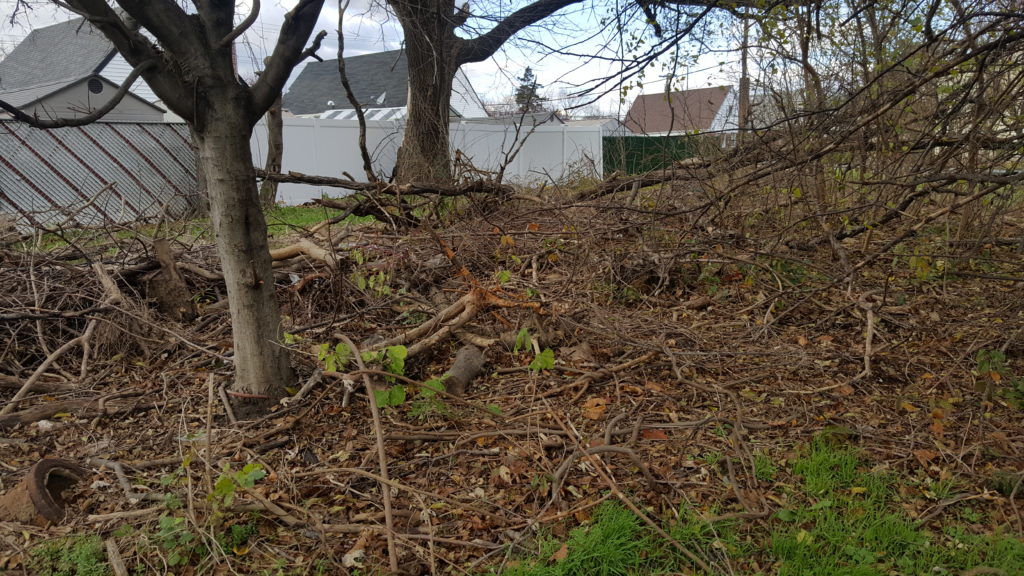 Our organization and the community members are eager to begin implementing plans to reopen the garden. The space will have comfortable seating area in front of a performance stage for school and senior day tours, an event tent for workshops and programs, the BANSAKEHM fountain, and a safe and monitored play area for kids. We will host Easter egg hunts, Mother Day Tea Parties, themed parties, contests with raffle prizes, multi-cultural music and dance festivals, as well as Annual Community Award Ceremonies for the community members recognition and ongoing engagement. Hopefully, the Hilton representatives will be motivated or interested to reengage the Holiday Garden once we launch HipHoticHelps Essential Garden and transform the property.
Our organization and the community members are eager to begin implementing plans to reopen the garden. The space will have comfortable seating area in front of a performance stage for school and senior day tours, an event tent for workshops and programs, the BANSAKEHM fountain, and a safe and monitored play area for kids. We will host Easter egg hunts, Mother Day Tea Parties, themed parties, contests with raffle prizes, multi-cultural music and dance festivals, as well as Annual Community Award Ceremonies for the community members recognition and ongoing engagement. Hopefully, the Hilton representatives will be motivated or interested to reengage the Holiday Garden once we launch HipHoticHelps Essential Garden and transform the property.
Thank you for holding this Oversight Hearing to examine Parks Department properties currently inaccessible to the public. Through fitness classes and health education, events, and entertainment for our youth, individuals, families, seniors and every else, our GreenThumb stewardship of this inaccessible Parks Department space will have benefits to the South Jamaica community. South Jamaica has a long history of violence, heartache, and despair. It’s now time to build a future of new culture through love, support, and togetherness. Turning these properties into real parks in collaboration with local residents will ensure their lasting benefit to our neighborhoods and City.
Trish Van Buren
HipHoticHelps Founder
(646) 258-5940
hiphotic@gmail.com
